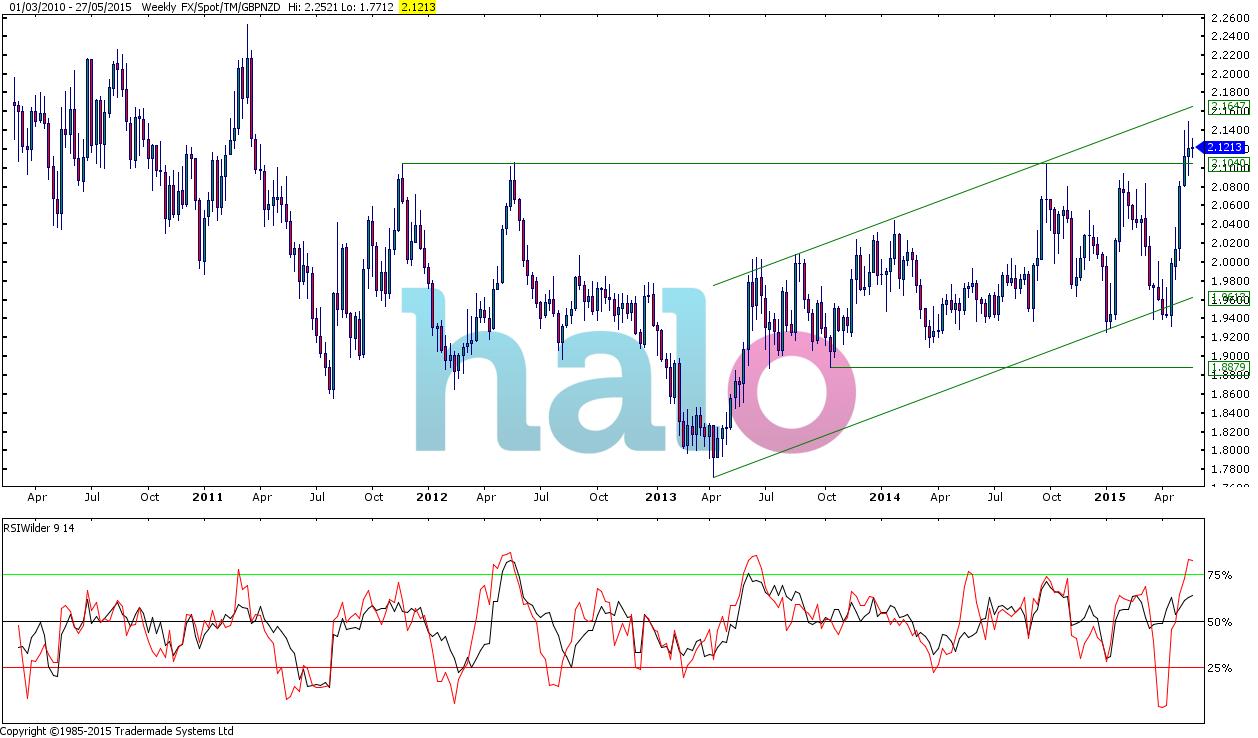New Zealand Dollar Research Report
GBPNZD Trading at 4 year highs
Sterling New Zealand Dollar (GBPNZD) FX Technical Analysis
Well what a difference a month can make, in the week commencing the 20th of April we traded as low as 1.93 in this currency pair. Following the shift in sentiment from the RBNZ (from a tightening to loosening bias) and the unexpected UK election result we have seen GBPNZD surge higher trading to the best rates we have seen since March 2011.
The RBNZ have had their hands relatively tied with regards to interest rates, due to the buoyant property market in Auckland. In order to pave the way for cutting interest rates (as the effect of drought, fiscal consolidation and the high exchange rates weigh on growth), the RBNZ have increased the deposit requirements for mortgages to 30% and have introduced capital gains tax on property transactions.
Given the stronger than expected retail sales and inflation expectation figures from NZ this month, I would suggest that a rate cut may not occur at the RBNZ’s June meeting and would personally favour a rate cut in July - following the release of Q2 inflation data (especially as the prospect of a rate cut has already significantly moved the exchange rates).
With the market now pricing in a rate cut from the RBNZ and the uncertainty over the UK political landscape lifted, we have seen GBPNZD rally to the highest levels we have seen since March 2011 which is a rally of almost of 22 cents or 11.5%. Meaning Kiwi buyers are approximately 10% better off today than on the 20th of April.
Technically, the break of 2.104 is significant. This has capped the market since March 2011 and has been tested on several occasions during this period. Over those 4 years, we saw the market trade as low as 1.78 but largely it remained within a range between 1.90 and 2.10.
As a rule of thumb, we would usually expect a market to trade the height of the previous trading range it the direction of the break out when it comes. As the previous trading range was 20 cents or so, this gives us a price target in the 2.30 region (20 cents from the break out level of 2.10). It is worth mentioning that we’re currently trading within an up channel the top of which is currently in the 2.1647 region meaning we are unlikely to see a move to the above price target for several months.
Buyers
The break of 2.104 is significant and great news for you. If you’re looking to trade in the near future, I would suggest targeting a rate below the current channel top i.e. 2.14-2.15. If you have a bit more time on your side, you may wish to target higher levels but I would recommend the placement of a stop loss below 2.104 (previous resistance now turned support) as a break of this level would suggest we’re going back into the trading range of the last 4 years i.e. 1.90-2.10.
Sellers
Unfortunately, we have broken out of the trading range of the last 4 years and this suggests we’re unlikely to be able to achieve rates of 2.00 or below once more. As an initial target 2.104 will prove solid support as this capped the market for so long. If this breaks we could potentially see a move towards the channel bottom (which would net you a rate in the 2.00 region as we speak) but overall it looks like sooner rather than later is the order of the day. Whilst it will be disappointing for some of you to trade at the current levels, it should be remembered that historically these are still excellent levels to sell the kiwi.
Trading foreign exchange on margin carries a high level of risk, and may not be suitable for all investors. The high degree of leverage can work against you as well as for you. Before deciding to invest in foreign exchange you should carefully consider your investment objectives, level of experience, and risk appetite. The possibility exists that you could sustain a loss of some or all of your initial investment and therefore you should not invest money that you cannot afford to lose. You should be aware of all the risks associated with foreign exchange trading, and seek advice from an independent financial advisor if you have any doubts.
Recommended Content
Editors’ Picks
EUR/USD clings to gains above 1.0750 after US data

EUR/USD manages to hold in positive territory above 1.0750 despite retreating from the fresh multi-week high it set above 1.0800 earlier in the day. The US Dollar struggles to find demand following the weaker-than-expected NFP data.
GBP/USD declines below 1.2550 following NFP-inspired upsurge

GBP/USD struggles to preserve its bullish momentum and trades below 1.2550 in the American session. Earlier in the day, the disappointing April jobs report from the US triggered a USD selloff and allowed the pair to reach multi-week highs above 1.2600.
Gold struggles to hold above $2,300 despite falling US yields

Gold stays on the back foot below $2,300 in the American session on Friday. The benchmark 10-year US Treasury bond yield stays in negative territory below 4.6% after weak US data but the improving risk mood doesn't allow XAU/USD to gain traction.
Bitcoin Weekly Forecast: Should you buy BTC here? Premium

Bitcoin (BTC) price shows signs of a potential reversal but lacks confirmation, which has divided the investor community into two – those who are buying the dips and those who are expecting a further correction.
Week ahead – BoE and RBA decisions headline a calm week

Bank of England meets on Thursday, unlikely to signal rate cuts. Reserve Bank of Australia could maintain a higher-for-longer stance. Elsewhere, Bank of Japan releases summary of opinions.
